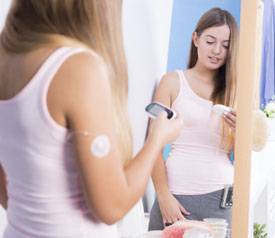
Insulin pumps and continuous glucose monitors allow people with diabetes to maintain tight blood glucose control. However, living with these devices can sometimes be challenging. This is especially true when it comes to exercising with an insulin pump. We review the things you need to know when you exercise with an insulin pump or a continuous glucose monitor.
Insulin pumps, continuous glucose monitors, and exercise can help control diabetes
As all people with diabetes know, controlling blood glucose levels is the key to avoiding short- and long-term diabetes complications. Insulin pumps and continuous glucose monitors can help people who take insulin keep very tight control of their blood sugar levels. Continuous glucose monitors measure blood sugar levels in real time, and insulin pumps can deliver just the right amount of insulin that the body needs without fingersticks or injections.
Exercise is another important component of diabetes care. Exercise can build muscle and make muscles more efficient at metabolizing glucose. Exercise can lower hemoglobin A1c, and can reduce the risk of developing and dying from heart disease.1,2
While it is clear than people who use insulin to control their diabetes greatly benefit from insulin pumps, continuous glucose monitors, and exercise, there are many practical barriers to making use of them.
Challenges of exercising with an insulin pump
Insulin pump users face two key problems when they exercise: glucose levels may become abnormally low (i.e. hypoglycemia) and their devices may become loose or, for continuous glucose monitors, fall off. One or both issues can be a hassle at best, or create severe problems, at worst.
Managing insulin while exercising
The main risk of exercising with an insulin pump is hypoglycemia (low blood sugar). In people without diabetes, insulin levels in the bloodstream are relatively low during exercise. The body needs some insulin to move glucose from the blood into tissues, but not so much insulin that blood glucose levels drop too much. An insulin pump can create this same internal environment, but it requires a bit of planning and programming.
NOTE: Talk to your diabetes doctor or endocrinologist before adjusting your insulin pump settings or starting a new exercise regimen.
In general, people who use an insulin pump may need to alter (lower to 80% or stop) their basal insulin flow when they plan to exercise vigorously.3 When possible, insulin boluses should be avoided prior to exercise. If an insulin bolus is required, it is better to use extended or slower acting insulin rather than short-acting preparations. Some insulin pumps have a “suspend” function when they detect blood sugar levels have dropped too far. If you use a continuous glucose monitor, you can see (or hear an alarm) if your blood glucose levels drop too far during exercise—without the need for fingersticks.4 Lastly, always exercise with a rapid-acting glucose source nearby (glucose tablets, full sugar fruit juices, etc.) in case you need to treat your own hypoglycemia during exercise.
Keeping insulin pumps secure during exercise
Certainly, glucose and insulin devices can help provide tight glucose control, but how do you keep continuous glucose monitors and insulin pumps secure during exercise? Any form of physical exercise puts stresses on devices or, more specifically, on the adhesives that are holding the devices on the body. With exercise comes sweat, which tends to loosen tapes and adhesives. Indeed, activities such as swimming may pose a real problem for people with certain types of devices.
Regardless of the type of insulin pump you use, keeping it in place is critical to proper functioning. A traditional insulin pump has an infusion set and tubing that must be held in place. While they are wireless and have no external tubing, insulin patch pumps attach directly to the body and are held in place with their own adhesive. Likewise, continuous glucose monitors have intrinsic adhesive backing. Unfortunately, these adhesives are not always capable of standing up to the rigors of vigorous exercise.5
Choosing the right tape for insulin pumps and continuous glucose monitors
Hy-Tape may be the ideal medical tape for securing continuous glucose monitors and insulin pumps during exercise. Hy-Tape is waterproof; when applied to a clean dry surface, it can hold fast in a moist environment. The Original Pink Tape® can stand up to the rigors of exercise, sweat, and water. The medical tape comes in thin rolls and strips that can be applied to the edges of patch insulin pumps and continuous glucose monitors. Hy-Tape provides a stronger, waterproof barrier over the devices’ own adhesive.
One of the unique features of Hy-Tape that makes it so useful during exercise is that it actually holds better when it warms up. The adhesive in Hy-Tape adheres more strongly at body temperature (or at slightly elevated body temperatures that occur during exercise) than it does at room temperature. This means that Hy-Tape can keep insulin pump tubing and infusion sets, patch insulin pumps, and continuous glucose monitors securely in place during vigorous exercise.
When it’s time to remove Hy-Tape, it comes off cleanly, gently, and without skin trauma, even on children’s more fragile skin.5 So, when it is time to remove the medical tape from insulin and monitoring devices, Hy-Tape is easy on skin and leaves no residue on devices.
If you have an insulin pump and/or a continuous glucose monitor and are contemplating exercise, ask your doctor about the best way to manage insulin delivery and glucose levels. When it is time to secure your device, try Hy-Tape. We offer a no obligation, free sample of Hy-Tape. We think you will agree that it is the ideal medical tape for securing insulin pumps and continuous glucose monitors, especially during exercise.
References
1. Yavari A, Hajiyev AM, Naghizadeh F. The Effect of Aerobic Exercise on Glycosylated Hemoglobin Values in Type 2 Diabetes Patients. J Sports Med Phys Fitness. 2010;50(4):501-505.
2. Lukács A, Barkai L. Effect of Aerobic and Anaerobic Exercises on Glycemic Control in Type 1 Diabetic Youths. World journal of diabetes. 2015;6(3):534-542. doi:10.4239/wjd.v6.i3.534
3. Franc S, Daoudi A, Pochat A, et al. Insulin-Based Strategies to Prevent Hypoglycaemia During and after Exercise in Adult Patients with Type 1 Diabetes on Pump Therapy: The Diabrasport Randomized Study. Diabetes Obes Metab. 2015;17(12):1150-1157. doi:10.1111/dom.12552
4. Grando MA, Groat D, Soni H, et al. Characterization of Exercise and Alcohol Self-Management Behaviors of Type 1 Diabetes Patients on Insulin Pump Therapy. Journal of diabetes science and technology. 2017;11(2):240-246. doi:10.1177/1932296816663746
5. Englert K, Ruedy K, Coffey J, et al. Skin and Adhesive Issues with Continuous Glucose Monitors: A Sticky Situation. Journal of diabetes science and technology. 2014;8(4):745-751. doi:10.1177/1932296814529893

